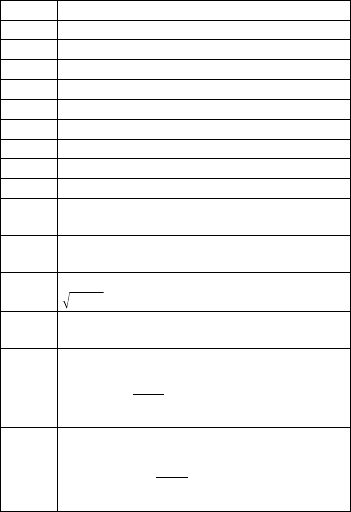
E-138
Functions Input Range
tanh
–1
x 0Ϲ ȊxȊ Ϲ9.999999999҂10
–1
logx/lnx 0 x Ϲ9.999999999҂10
99
10
x
–9.999999999҂
10
99
Ϲ x Ϲ 99.99999999
e
x
–9.999999999҂
10
99
Ϲ x Ϲ 230.2585092
'x 0Ϲ x 1 ҂
10
100
x
2
ȊxȊ 1҂
10
50
1/x ȊxȊ 1҂
10
100
;
x G
0
3
'x ȊxȊ 1҂
10
100
x!0Ϲ x Ϲ
69 (
x is an integer)
nPr
0Ϲ n 1҂10
10
, 0Ϲ r Ϲ n (n, r are integers)
1Ϲ {n!/(n–r)!} 1҂10
100
nCr
0Ϲ n 1҂10
10
, 0Ϲ r Ϲ n (n, r are integers)
1Ϲ n!/r! 1҂10
100
or 1Ϲ n!/(n–r)! 1҂10
100
Pol(x,
y)
Ȋ
xȊ, ȊyȊ Ϲ9.999999999҂10
99
x
2
+y
2
Ϲ9.999999999҂10
99
Rec(r,
)
0Ϲ
r Ϲ9.999999999҂10
99
θ
: Same as sinx
x0: –1҂10
100
ylogx100
^(
x
y
)
x҃0: y0
x0: y҃n, (m, n are integers)
However: –1҂10
100
ylogȊxȊ100
y0: x G 0, –1҂10
100
1/x logy100
x
'
y
y҃0: x0
y0: x҃2nѿ1, (m G 0; m, n are integers)
However: –1҂10
100
1/x logȊyȊ100
•Precision is basically the same as that described under
“Calculation Range and Precision” on page E-137.
•^(
x
y
),
x
'y,
3
', x!, nPr, nCr type functions require
consecutive internal calculation, which can cause
accumulation of errors that occur with each calculation.
•Error is cumulative and tends to be large in the vicinity of
a function’s singular point and inflection point.
m
2n+1
2n+1
m


















